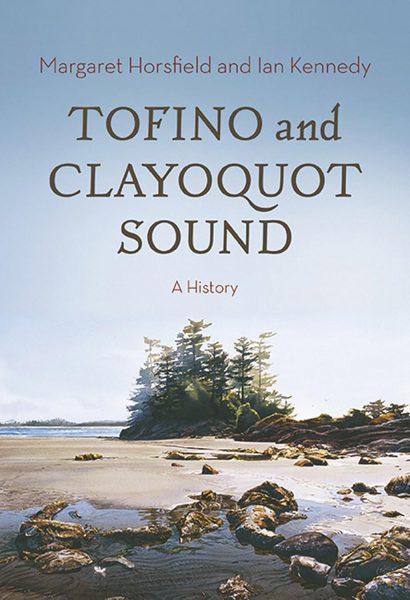
Tofino and Clayoquot Sound: A History
Review By Ian Rocksborough-Smith
October 10, 2024
BC Studies no. 223 Autumn 2024 | p. 130-132
For many British Columbians, Clayoquot Sound merely represents beautiful vacation destinations. It is typically now accessed via BC Ferries and a scenic car ride through the erstwhile inaccessible (of the early 20th Century) old growth forests west of Port Alberni towards the open Pacific Ocean and the seaside communities of Ucluelet and Tofino. It is a splendid (and not necessarily cheap) weekend get away that might take you to the famous Tin Wis resort (if you can afford it), or maybe a more affordable campground or surfing beach, not far from the West Coast Trail – where hiking usually requires reservations over a year in advance.
In the 2023 paperback edition of Tofino and Clayoquot Sound: A History (first published as a hardcover in 2014), authors Margaret Horsfield and Ian Kennedy write a history of what Jean Barman might call “the west beyond the west beyond the west.” In his own recent prescient review, historian Robin Fisher indicates the book is “a history of life on the fringe.”[1] In this 622-page tome (including index), the authors demonstrate how the area presents a fascinating, rich history of Indigenous life, colonial conflict, and determined, yet sparce settlements, as well as vibrant community life right through the 20th century and into the present one. It covers explorers, Indigenous chiefs, mining, canning, and fishery operations, as well as the often colorful, eccentric personalities who made their way to this far western outpost to homestead or establish businesses and livelihoods. Figures like Frederick Tibbs, a veteran of World War I, who clear cut a small island called “Dream Isle” with dynamite near Tofino to build a wooden “castle,” feature prominently in the book. Tibbs apparently used to play a cornet every day perched atop a branchless spruce tree converted into a tall ladder (p.222). Indeed, the fact that even the road between Ucluelet and Tofino was once simply stretches of Long Beach (open to tidal changes) through much of the early-20th century suggests the sort of hardy, if not eccentric individuals who likely came to see this as area as a viable “home.”
While the book has no footnotes, it is well researched and clearly reflects an intricate knowledge of the region, given the number of memoirs, oral histories, court records, and newspapers consulted and referenced in-text throughout the volume. All in all, it offers a fascinating, if at times rambling portrait of the personalities and local intrigues that shaped the gorgeous old-growth inlets, islands, and beaches that make-up this now prolific western-most edge of Canada. Comprising 22 chapters, Tofino and Clayoquot Sound: A History begins with the area’s geological past – touching on the well-known tectonic (and tsunami area) risks of living “on the edge” of the Cascadian subduction zone – set to experience the “big one” again in a not-too-distant future. Indeed, archeological studies of cedar trees in the region, in conjunction with Indigenous oral and Japanese written records of life in the 17th and 18th centuries, suggests the last “Big One” was roughly in 1699. It proceeds with some intricate chapters on the three Nuu-Chah-Nulth First Nations (Hesquiaht, Ahousaht, and Tla-o-qui-aht) who have called Clayoquot Sound home from time immemorial. Notably “The People of the Sound” (Ch. 2) and Ch. 12 and 13 on the highly unjust establishment of reserves and residential schools and the hard historical work increasing public knowledge of these events entails. Writing on the history of two residential schools in the region (one Presbyterian at Ahousaht and the other Catholic at Christie/Kakawis), the authors suggest that “[o]f all the disconnections faced by the original inhabitants of the area, this would be the worst of all: the growing disconnection from their own children as one generation after another passed through these schools” (p.256).
The scope of the book, which considers centuries (if not millennia) is a lot to cover for such a relatively small area (within British Columbia). And while at times very compelling with its prose, notably the early chapters on the “Bosten Men” on aggressive American sea captains who ventured up the west coast in search of otter pelts, as well as the intricate chapter on the 19th century sealing industry, which unsustainably moved away from the tried and tested methods of Indigenous harpooning, the chapters on the 20th century internment of the Japanese and the controversial protests over 1980s clear-cut logging in Clayoquot Sound are difficult to cover in small sectioned chapters as presented. Synthetic approaches to regional history are important and helpful, but this reviewer wonders whether one that covers such a small region can really do justice to any of these immense topics without book or dissertation length treatments of each rather than a broad survey? Moreover, one might suggest that some of this work could have been trimmed to be more accessible to a popular history audience – say if the book were 200-300 pages in length – especially for a paperback edition. All in all, it is a worthwhile read and offers a resource-rich portrait of an important region of the province that will undoubtedly continue to present itself as a world-class tourist destination. It showcases the potential of public engagement in these diverse histories of colonization and settlement. Time will tell whether the profits accrued by the operators of businesses in this region translates into programs for viable truth and reconciliation or environmental justice.
[1] Robin Fisher, “On the Ragged Edge,” The British Columbia Review (formerly the Ormsby Review) January 21, 2024). https://thebcreview.ca/2024/01/21/2044-fisher-horsfield-kennedy/ (accessed 8/13/2024)
Publication Information
Horsfield, Margaret and Ian Kennedy. Tofino and Clayoquot Sound: A History. Madeira Park: Harbour Publishing, 2023. 640 pp. $34.95 paper.
